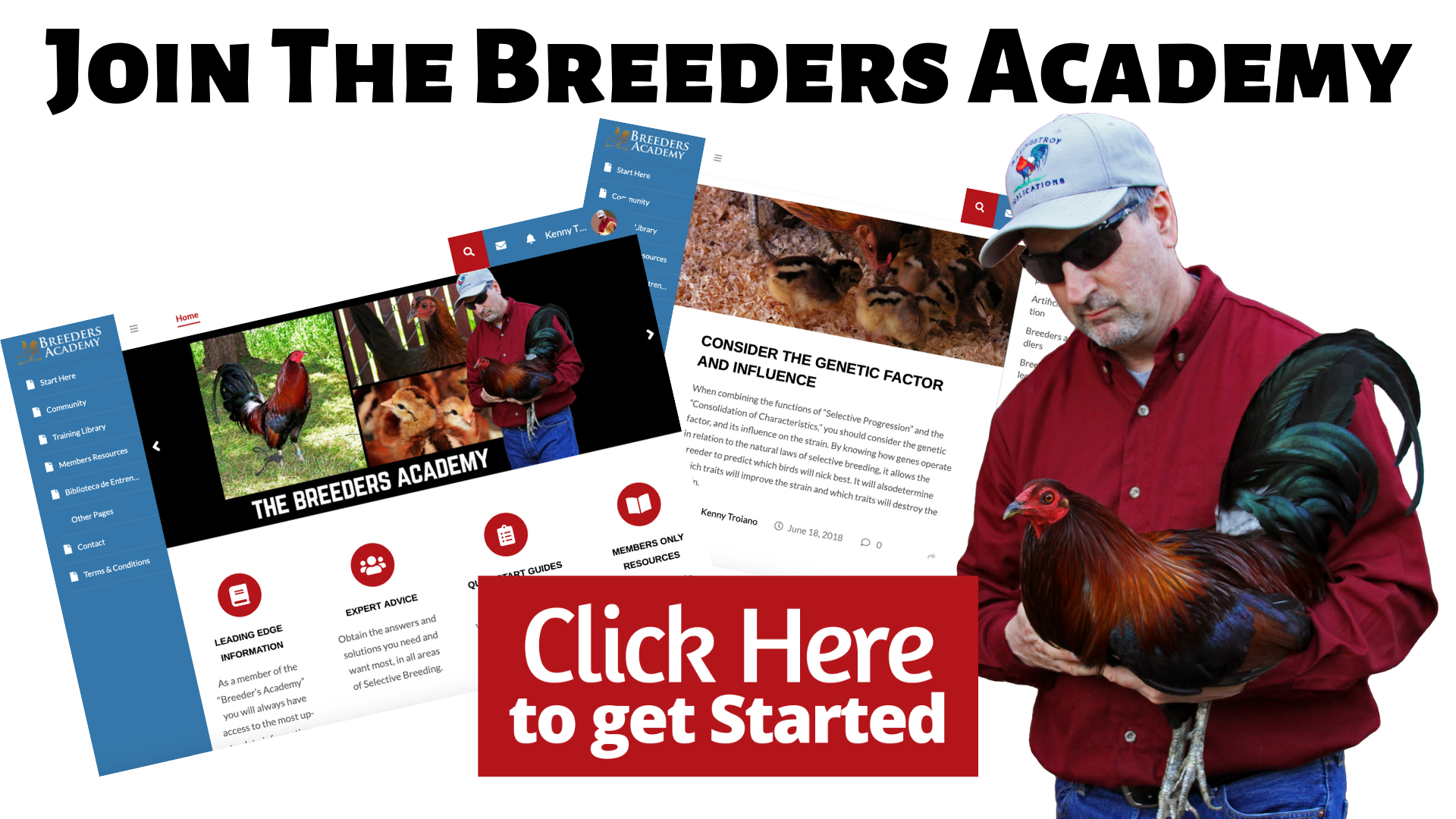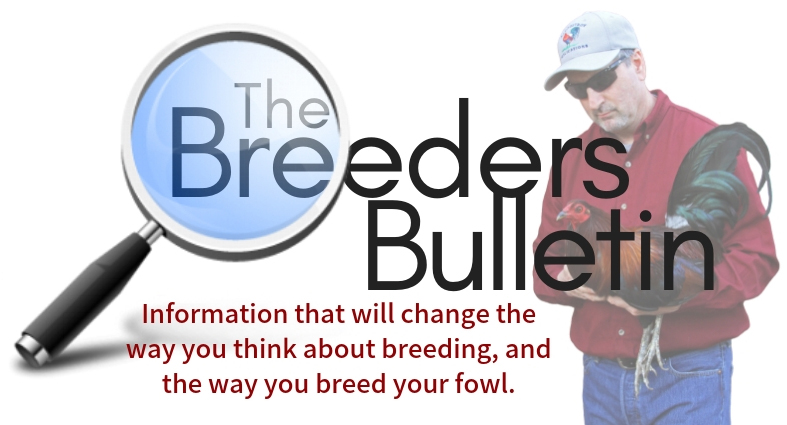I’m not going to say “my way is the only way,” I’m sure there are breeders out there who are achieving great results using other methods of breeding. However, there are three types of breeders, practicing particular ideologies, which I believe can have a devastating effect on the breed as a whole.
This is a dilemma that concerns me very much, as it should concern you as well. In the following paragraphs I will discuss their breeding practices, and what I believe is the eventual result of those practices.
The first believes in combining the traits of two separate and distinct breeds, such as American Games and Aseels, each having contrasting characteristics and traits, with the hopes that the traits of both breeds will be expressed in the offspring.
Not having a basic knowledge of genetics, and knowing the effects of dominant and recessive traits, as well as polygenic traits seldom do they get the results they are looking for.
I have no problem with those who use crossbreeding to achieve superior performance, but I do have a problem with these hybrid crosses being used as brood fowl. These breeders are unaware that the results they are getting are not from the combination of traits, but from hybrid-vigor. And when they breed to hybrid crosses, the results are unpredictability in the offspring and ultimately a transformation of the breed.
These breeders are oblivious to the science and practice of selective breeding and that there is a better and more proper way to get the results they are looking for.
Thanks to men like Gregor Mendel, Charles Darwin and Thomas Hunt Morgan, and many others, as well as, advances in modern science, especially in the areas of evolutionary biology, we now have a better understanding of the Laws of Selective Breeding. It is time to step out of the Dark Ages of breeding and start practicing proven principles.
The second type of breeder thinks they can mix the traits of two separate strains, such as Hatch and Sweater, and produce offspring expressing the best of both strains. They attempt this by breeding two separate strains of the same breed, but one is known for its superior performance ability, while the other has exceptional conformation of body. It is their belief that when the two strains are crossed, and the traits of each strain are combined, they will produce offspring having superior performance ability and an exceptional conformation of body. Again, this is wishful thinking.
Once you understand genetics, you will realize that specific biological laws dictate the inheritance of traits, and that traits are not mixed, but that some traits are expressed, while others are passed but remain hidden. To further complicate things, some traits can disappear entirely. If they happen to achieve the desired results, in most cases, it’s due to hybrid-vigor, not the mixing and recombination of genes.
It’s important to know that a substandard bird is a deficient bird, and a bird that has defects, is a defective bird. A bird that lacks in any traits, whatsoever, is substandard. A breeder should never breed a family of fowl that is dependent on another family of fowl to fix their faults. It’s the job of each breeder to make sure every strain on his farm is as complete as possible.
The third type of breeder that concerns me most is the breeder who believes that performance overrides all other factors. They place no importance on conformation of body, color of plumage, or temperament. Even defects are tolerated if the bird performs with excellence.
This type of breeder believes in the idea that winning is everything, and preaches, with conviction, the axiom – “As long as they’re winning, nothing else matters.” This kind of thinking can be very dangerous for the future of the breed, for the reason that the bird is performing well despite its defects or deficiencies. There are no guarantees his offspring will have the same ability to overcome their faults and perform well.
If this method of selection is practice by enough breeders, it could have a harmful effect on the structure of the breed. This way of thinking could be detrimental to the breed as a whole.
Here is a conversation I had on Facebook, with one of my readers. This was his response after reading my weekly newsletter, “The three most dangerous breeders.”
Reader: I read your newsletter, and I agree with you on all but one thing, some of the best breeders in the country breed Orientals to American Games. The great Bobby Boles being one. If you’re breeding to create battle-fowl then only one thing matters – are you producing winners at a high parentage? To me there is a difference between battle-fowl and brood fowl.
Kenny Troiano: Hey Brock, I can understand your point of view, however, to put this in perspective, battle-fowl are nothing more than hybrid crosses. I think we all can agree on that. It becomes a problem when you decide to put that hybrid cross in the brood pen. I believe a well-bred family does not need to be crossed to produce great fowl, and that, everything that is achieved by crossbreeding can be achieved through proper linebreeding and preserve through linecrossing, which is the breeding of related lines, both from the same family or strain.
Reader: Yes, but the whole reason for crossing is to make battle-fowl, and to put a trait that the pure family is lacking, which will make your battle-crosses perform better than the pure fowl, at least that is the goal of crossing.
Kenny Troiano: That is the goal, but the fact is, genetics and the passing of traits, and the expression of those traits operates much differently than most think. The results they are getting are from hybrid-vigor, not from the recombination and exchanging of traits. The truth is, crossbreeding is the lazy way of producing superior performance, and can be destructive to the breed.
Reader: I do agree that you don’t breed to battle-crosses, but I don’t battle brood fowl, at least I don’t like to, because in my experience crosses perform better than pure.
Kenny Troiano: Your pure fowl would do much better if you would create multiple lines within the same family and use linecrossing within the lines to improve genetic diversity. Trust me, this works much better than crossing unrelated strains. And the best part is, if you like how they perform, you can include them in your breeding program.
Breeding practices such as these only demonstrate how ignorant and inexperienced these breeders actually are. They rely on “Old Wives Tales” and “Superstitions.” Creating and producing superior, high quality fowl will always elude them. If they should ever be lucky enough to acquire some, they will not maintain that level for very long.
Breeders who think and practice in this manner will never reach the statue of Master Breeder, nor will they gain the respect of their peers. Without the proper knowledge and knowhow, to put these principles to practice, they will never reach the highest levels of success.
Within a few years they will become discouraged, lose interest, and quit. If they should persist, eventually they will blame the person they got their birds from, never taking responsibility for their actions. They will blame everyone but themselves. To satisfy their insatiable need to have something better, right now, they will spend their days looking for new blood.
I believe that until they are satisfied with what they have, and are willing to commit to one family, in addition to taking the time to learn this craft properly, they shouldn’t be breeding and perpetuating fowl at all.
I want to see those who care about the breed, and the future of the breed, to take the lead. I want to see those who are proficient at breeding high quality fowl to take care of all the breeding.
Until we understand, as a group, that it’s the total package we should perpetuate, such as, conformation of body, temperament, and ability, and yes, even their feather plumage, the breed as a whole will never improve. By selecting fowl, all having a complete package, we produce offspring that are true representatives of the breed.
As a family, your fowl must be well rounded and have great uniformity. Why is this important? It is important for the reason that each and every trait has a strong connection with other traits. Favor performance ability, while neglecting conformation of body, and you will ruin your fowl! All factors are important, and it is the complete bird that you should strive towards.
As lovers of American Games, we must become breeders again, and take responsibility for the fowl we produce.
Breeding can be a challenging undertaking, but with the basic knowledge and understanding of the principles and practices of selective breeding, not to mention lots of patience, progress can be made.
Special note of interest: I cover this information in greater detail in The Breeders Academy Membership Website. I encourage you to join, and I can help you take your strain to the next level, or help you create a new strain that you can be proud of.
Come check it out!

